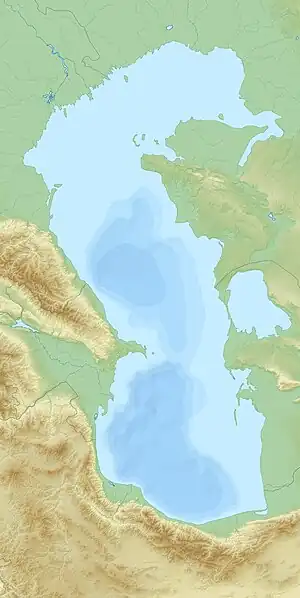Mangyshlak Peninsula
Маңғыстау түбегі Полуостров Мангышла́к | |
|---|---|
 | |
 Mangyshlak Peninsula | |
| Coordinates: 44°0′N 52°0′E / 44.000°N 52.000°E | |
| Country | Kazakhstan |
| Region | Mangystau Region |
| Sea | Caspian Sea |
Mangyshlak or Mangghyshlaq Peninsula (Kazakh: Маңғыстау түбегі, romanized: Mañğystau tübegı; Russian: Полуостров Мангышла́к, romanized: Poluostrov Mangyshlák) is a large peninsula located in western Kazakhstan. It borders on the Caspian Sea in the west and with the Buzachi Peninsula, a marshy sub-feature of the main peninsula, in the northeast. The Tyuleniy Archipelago lies off the northern shores of the peninsula.
The area is between desert and semidesert with a harsh continental dry climate. There are no rivers and no fresh water springs. Geologically, the Mangyshlak Peninsula is part of the Ustyurt Plateau. To the north, three mountain ranges stretch across the peninsula, the North and South Aktau Range and the Mangystau Range, with the highest point reaching 555 m.[1] Administratively, the peninsula is in Kazakhstan's Mangystau Province. The largest city, and the capital of the province, is Aktau (formerly Shevchenko).
This peninsula was formerly also known as Sīāhkūh (Persian: سیاهکوه) which means 'Black Mountain' in Persian.[2] The Mangyshlak peninsula was overtaken in 1639 by Kalmyks.[3] The peninsula's name stems from Ming Qishlaq, which means "1000 winter encampments" in Turkic languages.[4]
History
Upon the Soviet takeover of Russian Turkestan, the territory of the Transcaspian Oblast, which contained the Mangyshlak Peninsula, was initially assigned to the Turkestan ASSR. In August 1920, under pressure from Kazakh activists, Mangyshlak was transferred to the Kazakh ASSR.[5]
Cartography
The area was mapped by Fedor Ivanovich Soimonov during the Caspian Expedition, which surveyed the Caspian Sea from 1719 to 1727.[1]
 Map of the Mangyshlak Peninsula area showing the bays surrounding it. |
.jpg.webp) Map of the northeastern part of Caspian Sea with the Mangyshlak Peninsula at the bottom. |
Sources
- 1 2 Igor S. Zonn, Aleksey N Kosarev, Michael H. Glantz & Andrey G. Kostianoy, The Caspian Sea Encyclopedia, p. 285
- ↑ de Planhol, Xavier: (1990), CASPIAN SEA i. GEOGRAPHY, Encyclopædia Iranica. Vol.V, Fasc. 1, pp. 48-50
- ↑ Michael Khodarkovsky (1 October 2006). Where Two Worlds Met: The Russian State and the Kalmyk Nomads, 1600-1771. Cornell University Press. pp. 83–. ISBN 0-8014-7340-3.
- ↑ Woods, John E. (1999). The Aqquyunlu : clan, confederation, empire. Salt Lake City: University of Utah Press. p. 238. ISBN 0-585-12956-8. OCLC 44966081.
- ↑ Khalid, Adeeb (2019). Making Uzbekistan: Nation, Empire, and Revolution in the Early USSR. Cornell University Press. pp. 268–269. ISBN 9781501735851. Retrieved 12 January 2024 – via Internet Archive.
The creation of separate national oblasts for the three main nationalities was written into the Politburo resolution of June 1920 that defined Turkestan's place in the Soviet state as an important goal of Soviet power in Turkestan. A different kind of pressure came from the demands, increasingly insistent, from Kazakh activists from outside Turkestan. Upon Alash Orda's defeat, the Kazakh lands of the former Steppe krai were turned into an autonomous Kazakh Republic with its capital at Omsk. In August 1920, the Kazakh-dominated Manghishlaq Peninsula was transferred from Turkestan to the Kazakh Republic.
External links
- The wildlife of Mangyshlak (in Russian)
- Kazakhstan Nuclear Facilities: Mangyshlak Atomic Energy Combine at the site of the Nuclear Threat Initiative.
44°0′N 52°0′E / 44.000°N 52.000°E